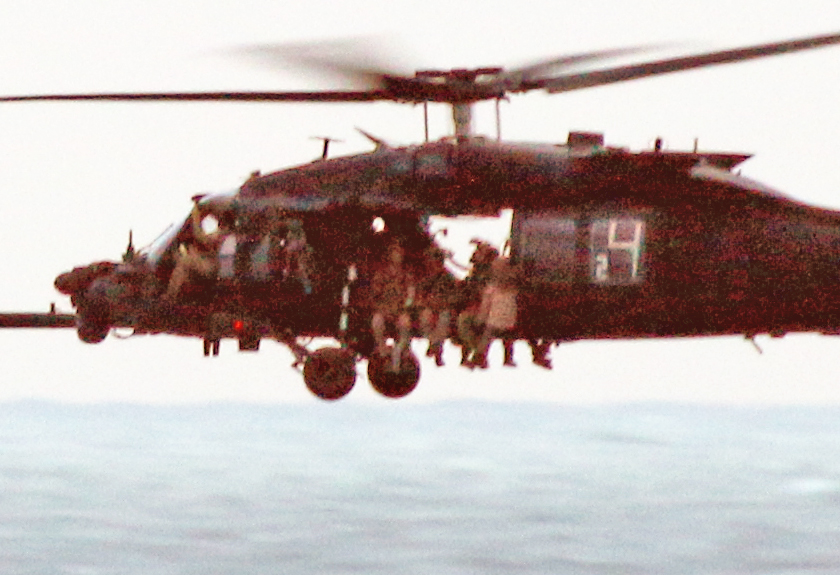Images May Show Special Operations Unit Training with DEVGRU or Army Delta.
Frequent contributor to The Aviationist, Lance Riegle, of Dearborn Heights, Michigan, noticed unusual aviation activity during his recent trip to Virginia Beach, Virginia. He grabbed his Canon EOS 70D with a Tamron 70-300mm f/4-5.6 lens and started shooting photos. What he got is interesting.
“To be honest, I started taking photos before I knew what I was taking photos of. There had been a lot of other activity from the airshow [Ed’s note: the NAS Oceana Airshow had just ended that weekend] and I had my camera ready to go next to the balcony where we were staying. I heard jets, then I heard a helicopter, ran out the door, and there they were.”
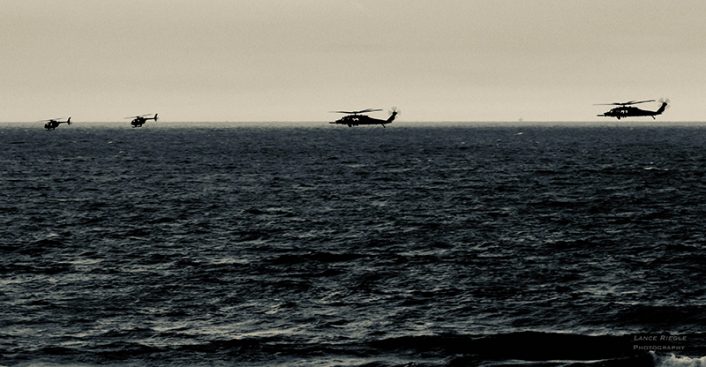
Virginia Beach is close to the Dam Neck Annex of Oceana Naval Air Station. In December, 2016, journalist Sarah Pruitt reported on the use of the classified area by the most famous special operations unit in the world, the Navy’s elite SEAL Team 6. The unit, also known as “Development Group” or “DEVGRU” trains in this facility.
Pruitt wrote that, “Today, the top-secret headquarters of SEAL Team Six are located at the Dam Neck Annex of the Oceana Naval Air Station, just south of Virginia Beach.” Lance Riegle was only six miles north of the top-secret facility.
The general public knows DEVGRU from Operation Neptune’s Spear, the raid to capture Osama bin Laden in 2011 using highly-modified “Stealth Black Hawk” helicopters flown by the U.S. Army’s 160th Special Operations Aviation Regiment (160th SOAR), the famous “Night Stalkers”.
While the military won’t officially verify it, what Lance Riegle got photos of just north of Dam Neck was almost certainly a (classified) training exercise being conducted by a Naval Special Warfare Team (SEAL team), possibly DEVGRU operators, using highly modified helicopters only flown by the 160th SOAR. The aircraft in the photos are MH-6M Little Bird and MH-60M Blackhawk helicopters.
The Night Stalkers’ unusual helicopters are readily identifiable during the day. They are painted flat black instead of the more common olive green color and have almost no visible markings. The aircraft Lance Riegle photographed had temporary markings on the fuselage using tape, a common practice in a large training evolutions using numerous aircraft.
The Nightstalkers are the only unit in the Army using the MH-6M Little Bird, the helicopter you may remember landing on the roof of the Olympic Hotel in the book and movie “Blackhawk Down” when the secretive SFO-D (Special Forces Operational detachment- Delta) assaulted the building.
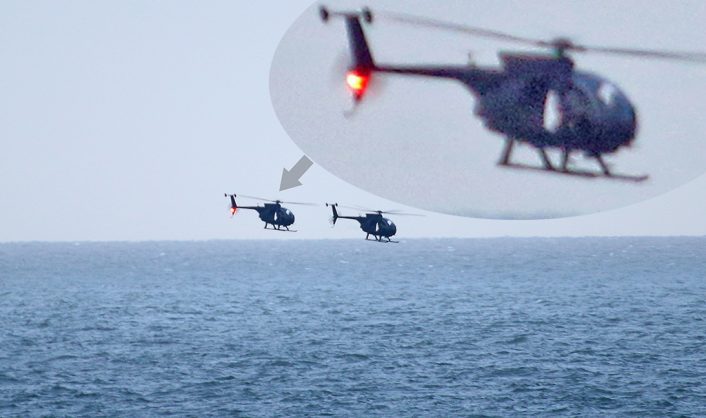
The U.S. Army’s 160th SOAR specializes in night flying at low altitude for clandestine insertions into denied areas. Aircraft flown by the Nightstalkers have an exotic communications and sensor suite on board accounting for the massive number of antennae and vision systems protruding from the helicopters. The MH-60M Blackhawks have a dazzling array of special secure radios, sensors and satellite communications on board. They include the AN/ARC-201D single channel ground and airborne radio system (SINCGARS), four onboard Raytheon AN/ARC-231 Skyfire radios, two of them equipped with satellite communications capability, two AN/ARC-220 high frequency radios, an MTX Blue Force Tracker to prevent accidental friendly fire engagements. The nose of the MH-60M also features the Raytheon AN/APQ-187 SilentKnight radar for terrain-following at low altitude at night and the Raytheon AN/ZSQ-2 EOSS electro-optical (EO) and infrared (FLIR) cameras for night vision. Nightstalker pilots are also the most proficient aviators in the world at dangerous low-altitude, night vision goggle flying. All these system antennae and sensors are visible in Riegle’s photos.
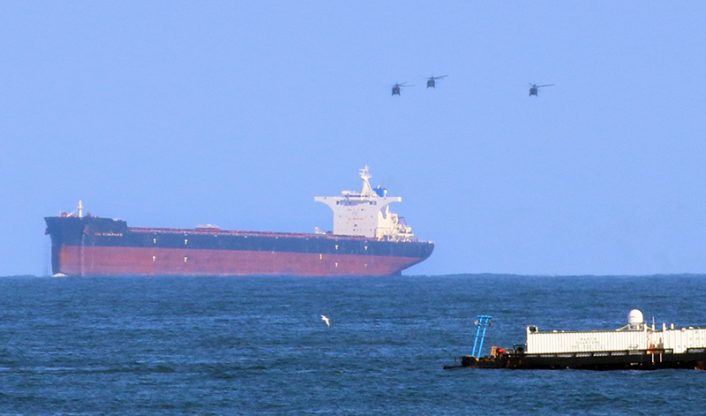
“The first time I saw them was at night. I was surprised they were flying as close to the ground and to buildings as they were at night with all their lights off. The only light they had on was one small, blinking tail light.”
Training activities for these elite teams are common in the area, but being in the right place at the right time to get photos can be tricky, especially for a large training exercise like this one. Riegle observed the aviation activity for four days at multiple times throughout the day. The aircraft would fly in and out of two points, sometimes loaded with operators, sometimes returning empty. The aircraft originated north of Riegle’s location and then flew south to Dam Neck initially before heading out to sea. This mission profile suggests the aircraft and their load of special operators could have been conducting Visit, Board, Search and Seizure (VBSS) operation training. “At night, they stayed closer to shore, during the day they were further out,” Riegle noted.
Once Lance Riegle began noticing the high tempo of special operations activity in the area he kept his camera with him and managed to grab some photos of the rarely seen stealthy 41-foot CCA Mk1 high speed boats used by Special Boat Team 20 stationed at Dam Neck.
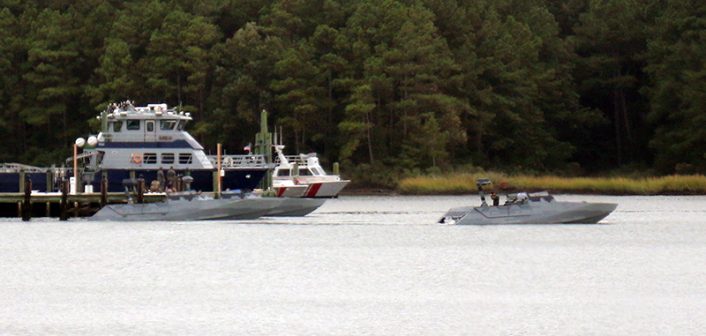
In August 2017 journalist Joseph Trevithick reported at The War Zone that, “From what little we know about the 41-foot long craft, technically known as the CCA Mk. 1, it is low-observable design with a composite material hull and a pair of high performance engines that could operate with a low likelihood of detection even close to shore. It is reportedly small enough that U.S. Air Force C-17s can air drop it directly into a given body of water.”
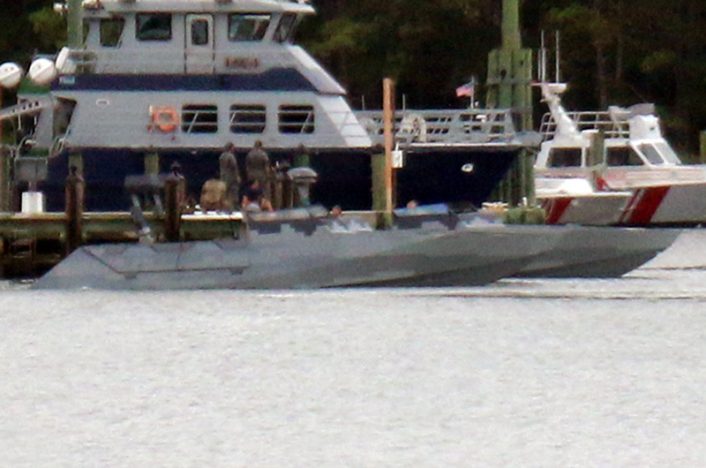
Following a few days of managing to get some rare photos of these secretive aircraft, boats and special operations teams in training Riegle said, “It’s interesting that these guys do this every day around the world but nobody ever sees them including us Americans.” Thanks to Lance’s interesting photos, we get a rare glimpse at these exotic aircraft, boats and men in action.
All images: Lance Riegle.
Top image: A grainy close-up of an MH-60M Blackhawk of the U.S. Army’s 160th SOAR, the “Night Stalkers” flies just off the coast of Dam Neck. The numerous sensors, the night vision goggles on the helmets of operators and their unusual uniforms with knee pads can barely be seen in this enlargement. (Photo: Lance Riegle)

